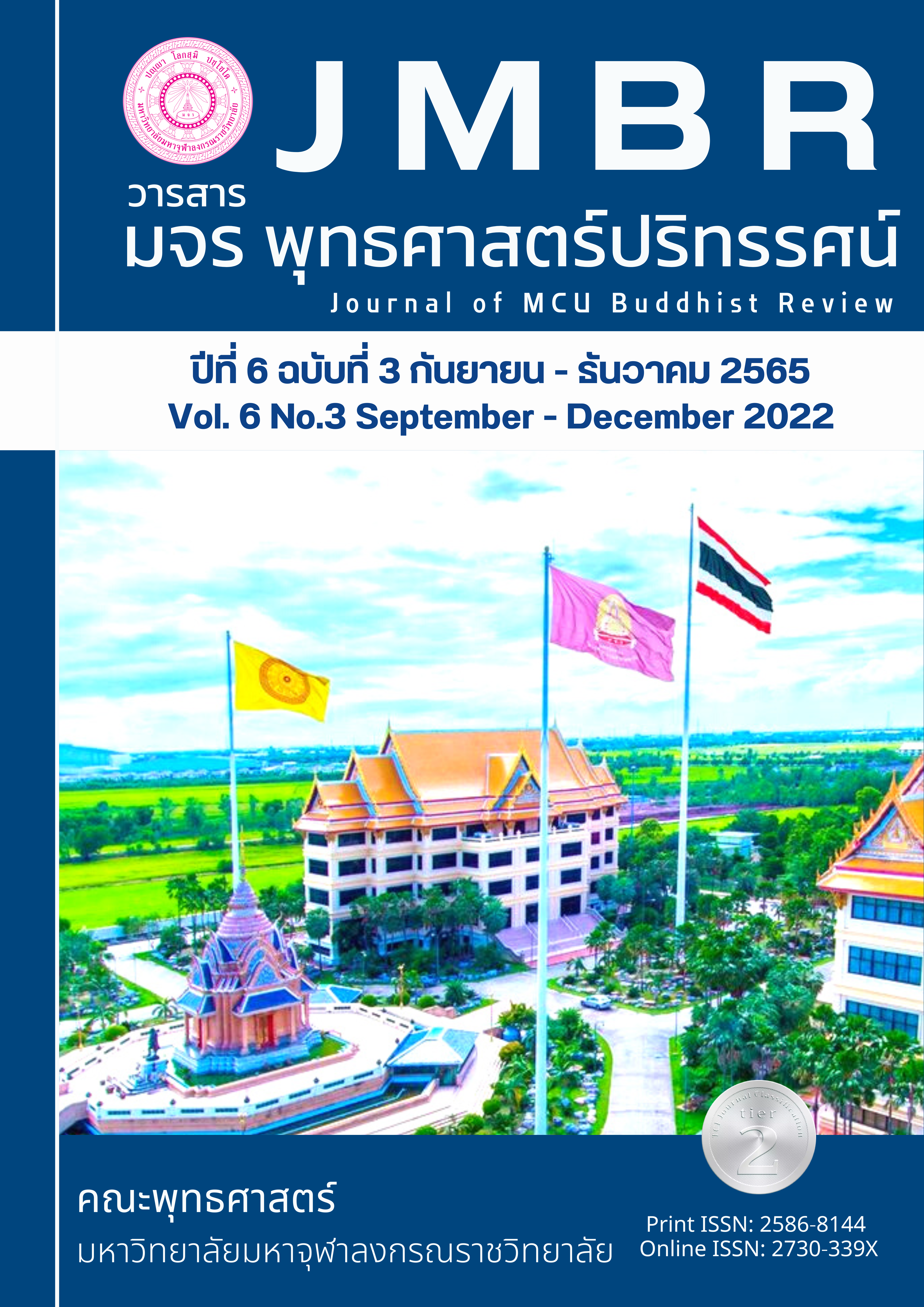การศึกษาเปรียบเทียบแนวคิดเรื่องวัวลัมบูในศาสนาพราหมณ์-ฮินดู ของกลุ่มชาติพันธุ์บาหลีประเทศอินโดนีเซียกับนกหัสดีลิงค์ ในพระพุทธศาสนาเถรวาท จังหวัดอุบลราชธานี
Main Article Content
บทคัดย่อ
บทความวิจัยเรื่องนี้ มีวัตถุประสงค์ 3 ประการ คือ (1) เพื่อศึกษาแนวคิดเรื่อง “วัวลัมบู” ใน ศาสนาพราหมณ์-ฮินดู (2) เพื่อศึกษาแนวคิดเรื่อง “นกหัสดีลิงค์” ในพระพุทธศาสนาเถรวาท (3) ศึกษาเปรียบเทียบแนวคิดเรื่อง “วัวลัมบู” ใน ศาสนาพราหมณ์-ฮินดู และ แนวคิดเรื่อง “นกหัสดีลิงค์” ในพระพุทธศาสนาเถรวาท ด้วยวิธีการศึกษาเอกสารและการสัมภาษณ์ ผลการศึกษาพบว่า พิธีกรรมชาวบาหลี “วัวลัมบู”รูปแบบพิธีเผาศพ ศิลปกรรมที่สะท้อนกระบวนการทางสังคมพิธีกรรมเผาศพของกลุ่มคนที่เชื่อในเรื่องเทพเจ้า จิตวิญญาณ และชีวิตที่รวมเป็นหนึ่งของสังคมและวัฒนธรรมบาหลีการเชื่อมโยงสร้างเรื่องราวว่า วัว คือเทพเจ้าที่จะนำคนตายไปสู่สวรรค์ คนบาหลีเชื่อเรื่องการกลับชาติมาเกิดใหม่ คติความเชื่อนี้ได้มีความเชื่อสอดคล้องกับนกหัสดีลิงค์กับพิธีเผาศพอันเป็นความเชื่อที่เกิดขึ้นต่อเนื่องมาจากการผสมผสานความเชื่อของศาสนาพุทธ ศาสนาพราหมณ์-ฮินดู อันเกี่ยวเนื่องในความเชื่อของไตรภูมิ การสร้างเมรุเป็นรูปนกหัสดีลิงค์ในงานพิธีปลงศพชนชั้นเจ้านายและพระเถระชั้นผู้ใหญ่ตามคตินิยมโบราณของชาวอีสานนั้นจึงมีรากฐานมาจากคติความเชื่อที่ว่า นกหัสดีลิงค์ คือสัตว์ในอุตตรกุรุทวีป อีกคติความเชื่อหนึ่งที่ว่า นกหัสดีลิงค์คือสัตว์หิมพานต์ เป็นนกใหญ่ที่มีพละกำลังมากสมควรที่จะเป็นพาหนะของเจ้านายผู้สูงศักดิ์และพระเถระชั้นผู้ใหญ่นำดวงวิญญาณขึ้นสู่สรวงสวรรค์ตามความเชื่อในทั้งสองศาสนา
Article Details

อนุญาตภายใต้เงื่อนไข Creative Commons Attribution-NonCommercial-NoDerivatives 4.0 International License.
- บทความที่ได้รับการตีพิมพ์เป็นลิขสิทธิ์ของวารสาร มจร พุทธศาสตร์ปริทรรศน์
- ข้อความใดๆ ที่ปรากฎในบทความที่ได้รับการตีพิมพ์ในวารสาร ถือเป็นความรับผิดชอบของผู้เขียนบทความ และข้อคิดเห็นนั้นไม่ถือว่าเป็นทัศนะและความรับผิดชอบของกองบรรณาธิการวารสาร มจร พุทธศาสตร์ปริทรรศน์
เอกสารอ้างอิง
กรุณา กุศลาสัย. (2554). ภารตวิทยา. พิมพ์ครั้งที่ 7. กรุงเทพมหานคร: ศยาม.
คมกฤช อุ่ยเต็กเค่ง. (2559) “ฮินดูกินวัว การเมืองเรื่องอาหารในอินเดีย”. กรุงเทพมหานคร: มติชน.
จำนงค์ ทองประเสริฐ. (2540). บ่อเกิดลัทธิประเพณีอินเดีย.กรุงเทพมหานคร: อรุณการพิมพ์.
ชนินทร์ ไชยศิริ, (2560). “พระเมรุ” สถาปัตยกรรมสุดท้ายของชีวิตบนดินแดนสุดท้ายของฮินดูชนแห่งหมู่เกาะบาหลี, งานพระเมรุ: ศิลปะสถาปัตยกรรมประวัติศาสตร์และวัฒนธรรมเกี่ยวเนื่อง, พิมพ์ครั้งที่ 6, (กรุงเทพมหานคร: สํานักพิมพ์มติชน.
เชษฐ์ ติงสัญชลี. (2558). ศิลปะชวา. กรุงเทพมหานคร: มติชน.
เทวทัตต์ ปัตตะไนก์.(2562).เทพปกรณัมอินเดีย. แปลโดย ปัณณวิชย์ ผสมทรัพย์.กรุงเทพมหานคร: ยิปซี่ กรุ๊ป.
นันทวัน เพ็ชรวัฒนา. (2554). บาหลี เกาะแห่งความลึกลับ. กรุงเทพมหานคร: บี.ซี.พับลิเคชั่น, 2532.
ปรมหังสา โยคานันทะ. (2561). ภควัทคีตา: ราชศาสตร์แห่งการหยั่งรู้พระเจ้า. กรุงเทพมหานคร: อมรินท์พริ้นติ้ง.
ประทับใจ สิกขา. (2556). นกหัสดีลิงค์. อุบลราชธานี: โรงพิมพ์มหาวิทยาลัยอุบลราชธานี.
พรหมา พิทักษ์. (2537). บก.นัยแห่งสัญลักษณ์, กรุงเทพมหานคร: สำนักพิมพ์ต้นธรรม.
พระธรรมกิตติวงศ์ (ทองดี สุรเตโช). (2550). ศัพท์วิเคราะห์. กรุงเทพมหานคร: โรงพิมพ์เลี่ยงเซียง.
พระพรหมคุณาภรณ์ (ป.อ.ปยุตฺโต). (2552). กาลานุกรม : พระพุทธศาสนาในอารยธรรมโลก. พิมพ์ครั้งที่ 3. กรุงเทพมหานคร: ผลิธัมม์.
ฟื้น ดอกบัว. (2561). ศาสนาเปรียบเทียบ. พิมพ์ครั้งที่ 4. กรุงเทพมหานคร: ศิลปาบรรณาคาร.
ยูวัล โนอาร์ แฮรารี่(2554). เซเปียนส์ : ประวัติย่อมนุษยชาติ. แปลโดย ดร.นำชัย ชีววิวรรธน์. กรุงเทพมหานคร: ยิปซี กรุ๊ป.
ราชบัณฑิตยสถาน.(2546). พจนานุกรม ฉบับราชบัณฑิตยสถาน พ.ศ. 2542. กรุงเทพมหานคร: ราชบัณฑิตยสภา.
ลิไทย, พญา.(2551). ไตรภูมิกถา หรือ ไตรภูมิพระร่วง. พิมพ์ครั้งที่ 4. กรุงเทพมหานคร: องค์การค้าของ สกสค.
ส.พลายน้อย. (2552). สัตว์หิมพานต์. พิมพ์ครั้งที่ 4. กรุงเทพมหานคร: สำนักพิมพ์พิมพ์คำ.
ธีรภาพ โลหิตกุล, (2556). มนตราอาเซียน เปิดประตูใจสู่การเรียนรู้วิถีวัฒนธรรมเพื่อนบ้านจากประสบการณ์สองทศวรรษสัญจร, กรุงเทพมหานคร: สำนักพิมพ์มติชน.
ชัยภัทร ปทุมทา; พระครูพิพัฒน์สุตคุณ; พระปลัดทัศนพล เขมจาโร; กวีภัทร ฉาวชาวนา; นพวรรณ์ ไชยชนะ, (2554). “สัตว์สัญลักษณ์ทางพระพุทธศาสนา : การสังเคราะห์คติธรรมและความเชื่อสู่การสร้างสรรค์พุทธศิลปกรรมของวัดในจังหวัดพิจิตร”. รายงานวิจัย. สถาบันวิจัยพุทธศาสตร์: มหาวิทยาลัยมหาจุฬาลงกรณราชวิทยาลัย.
ศาสนาพราหมณ์-ฮินดู–กระทรวงวัฒนธรรม, (2554). กรมการศาสนา และอนุกรรมการส่งเสริมกิจการศาสน และศาสนิกสัมพันธ์ คณะกรรมาธิการ การศาสนา คุณธรรม จริยธรรม ศิลปะและวัฒนธรรม วุฒิสภา. วิถีชีวิต 5 ศาสนิกในประเทศไทย. กรุงเทพมหานคร : บริษัท รำไทยเพรส จำกัด. พิมพ์ครั้งที่ 5.
Eiseman, Fred B. (1989). Bali: Sekala & Niskala Volume I: Essays on Religion, Ritual, and Art. Singapore: Periplus Editions.
Drs. I Nyoman Singgin Wikarman, (2002). NGABEN (upacara dari tingkat sederhana sampaiutama) NGABEN (พิธีจากระดับง่ายไประดับหลัก), Penerbit Paramita Surabaya.


